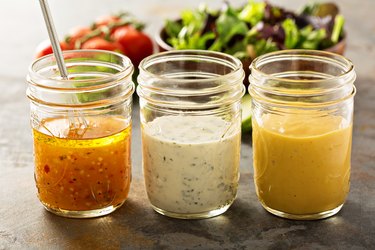
Raw leafy greens and watery vegetables are among the lowest-carbohydrate foods available, so you can eat lots of salads while on a low-carb plan like the keto diet. But what about salad dressings?
Good news: Dressing your veggies is fine on most low-carb diets. Most of these eating plans don't offer any hard-and-fast rules for choosing salad dressings, but, in general, the lower in carbohydrates, the better. (Some diets do have guidelines, at least for the first weeks: In Phase 1 of the Atkins diet, for example, any salad dressing with no added sugar and 3 grams of carbohydrates or less per serving is allowed.)
Video of the Day
Video of the Day
Here's what to know about shopping for diet-friendly dressings or — better yet — making your own.
Read more: Foods to Eat While on a Ketogenic Diet
How to Choose a Low-Carb Salad Dressing
Oil-based bottled dressings are often low in carbs, says Franziska Spritzler, RD, author of The Low-Carb Dietitian's Guide to Health and Beauty, especially if they contain no added sugar or starch-based thickeners. "The best salad dressing, hands down, is olive oil and vinegar or olive oil and lemon juice," says Spritzler.
It is possible to find commercial salad dressings that stick to the basics, and only add salt or spices (instead of sugar and starch) for flavoring. Newman's Own Classic Olive Oil & Vinegar dressing, for example, contains only olive oil, water, vegetable oil, red wine vinegar, mustard, onion, salt, lemon juice concentrate, distilled vinegar, garlic, black pepper and celery salt. A 2-tablespoon serving contains just 1 gram of carbohydrates.
Some creamy dressings get the thumbs up on low-carb diets, as well. "In general, dressings that aren't sweet are better than those that are," says Spritzler. "So blue cheese, ranch and Caesar are probably going to be lower-carb than things like thousand island, French or honey mustard."
Just watch out for salad dressings advertised as low-fat, since these often have sweeteners added to boost flavor.
When shopping for any salad dressing, read both the ingredient label and carbohydrate count on the nutrition facts panel. Look for added sugars, which can show up on an ingredient list as fructose, corn syrup, honey, fruit juice concentrate or other sneaky names. "Sugar is in a lot of salad dressings, but it should at least be toward the end of the ingredient list, which means it's in smaller amounts," says Spritzler. (Pro tip: Ingredients are listed in order by the amount present in a product.)
Make Your Own Low-Carb Dressings
You can also make your own salad dressing by combining an oil, an acid, herbs and spices. For example, red wine vinegar makes an essentially carb-free, all-purpose dressing when blended with olive oil, salt, black pepper and chopped shallots.
Lemon juice, lime juice and balsamic vinegar are other acidic ingredients you could sub for red wine vinegar. Make a tangy lemon vinaigrette for bitter greens such as arugula with lemon juice, walnut oil, thyme leaves, salt and black pepper. Mix balsamic vinegar with olive oil, salt, black pepper and chopped garlic to dress a hearty steak and avocado salad on romaine leaves.
Tip
Whether you're buying a salad dressing from the store or whipping one up at home, it's important to keep portion sizes in mind. "If a product or a recipe says there's only 2 grams of carbs per 2-tablespoon serving, but then you're using 5 tablespoons on your salad, then you have to multiply the number of carbs you're really going to get," says Spritzler.
Other Low-Carb Condiments for Vegetables
Mayonnaise with no added sugar is allowed on low-carb eating plans — even strict ones like the ketogenic diet. Use it to add flavor to a tuna or chicken salad made with chopped celery and herbs. Or make a chunky cucumber dressing by seeding, peeling and chopping a cucumber, and mixing it with mayonnaise, lemon juice, chives and garlic. This dressing works best for hearty greens, such as romaine or chicory leaves.
For those on more moderate low-carb diets, plain Greek yogurt — with 4.5 grams of carbs per 1/2 cup, according to the USDA — can be the base for a creamy dressing. Create a mock-Caesar dressing by blending together plain yogurt with a dash each of mustard, Parmesan cheese, minced garlic, chopped anchovies, red wine vinegar, lemon juice and salt and pepper to taste.
If you're eating out and can't check the ingredient label of the restaurant's salad dressing to find out if it has added sugar or starch, ask for plain oil and vinegar, says Spritzler. Then, load up your salad with tasty, low-carb ingredients to make it satisfying. Chopped egg, avocado, chicken breast, bacon, grated or crumbled cheese and fresh herbs will provide plenty of flavor, even if your dressing is rather bland.